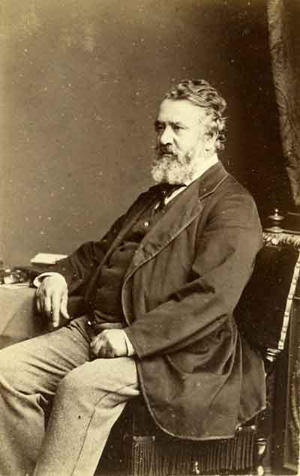1840 - 1860

Henry Joseph Whitlock (Birmingham)
William Freeman Jnr.
Carte-de-visite, 1877
[Private collection]
William Philip Barnes Freeman, a.k.a. William Freeman Jnr., was a member of a family firm of carvers, gilders and looking glass manufacturers, which also sold prints and artists’ materials and carried out picture restoration. The firm was established in 1788 in London Lane, Norwich by his grandfather Jeremiah Freeman (1763-1823), who was joined in 1809 by William Jnr.’s father, William Freeman (1784-1877) who was Mayor of Norwich in 1843-4. The 1851 census reveals that the firm employed 37 men, 11 women and 15 apprentices. All three generations of Freeman were landscape painters who exhibited with the Norwich Society of Artists. Jeremiah became its President in 1818 and, likewise, William in 1820. William Freeman Jnr. was an accomplished painter in watercolour and oils and a member of what has come to be known as the Norwich School of Painters. Undoubtedly the Freeman firm would have been responsible for framing paintings of many of the Norwich School artists for the Society’s exhibitions.
William Jnr. received his early education under Captain Bailey, at Hellesdon. A fellow pupil was Mike Crome, the youngest son of John Crome, the artist, and William remembered going with his schoolfellow into “Old Crome’s” studio and watching him paint. After Hellesdon he went to the Rev. Mr. Bowles’ academy, at Great Yarmouth, where he received lessons in drawing from John Sell Cotman. His education was completed at the Norwich Grammar School, under the headmastership of Dr. Edward Valpy. His art studies continued under John Sell Cotman for water colour, and under John Berney Ladbroke for oil painting. Although he could read Greek as easily as most people read English, he didn’t go university but travelled abroad. His father, William, wanted his son to become a clergyman but he changed his mind and said he must join the family business, as he was the eldest son. When his father William died, no Freeman was prepared to continue with the business and it was taken on by William Boswell who had been apprenticed there many years before. William Jnr. moved to Pottergate, later to Lakenham and then King Street.
He friends included David Cox (with whom he frequently went sketching in the neighbourhood of Birmingham), James Stark, Henry Bright and George Vincent. Among the numerous exhibitions at which William Jnr. was a contributor were the Royal Academy, Royal Society of Artists, Liverpool, Manchester, Birmingham and Glasgow. He showed his work regularly in Norwich exhibitions between 1842-1889 and joined the local archaeological society in 1848.
Both William Jnr. and his father had an interest in photography and the first meeting of the Norwich Photographic Society was held at the Freeman premises in June 1854. In the 1864 Norwich Directory, William Jnr. was listed as a photographer as well as carver and gilder. In 1856 he moved to Rampant Horse Street, taking on the photographic studio vacated by Mr. Sarony. [See advertisements in the Gallery] William Jnr. showed five portraits in the 1856 Norwich Photographic Society exhibition, four distinguished by type: ‘Untouched’, ‘Sepia’, ‘Tinted’ and ‘Highly finished’. None of his photographs are known to have to have survived.
He was married twice, first to Katherine Muskett, by whom he had eight children, and then to Mary Hogarth, who gave birth to another eleven children.
Sources and Notes
Private correspondence.
Norwich Castle Museum archive:
Reminiscences of Florence Woodbine, 1969.
Notes from Gertrude M. Rolfe, grand-daughter of W.P.B. Freeman.
Obituary. Eastern Daily Press, 16th September 1897.
